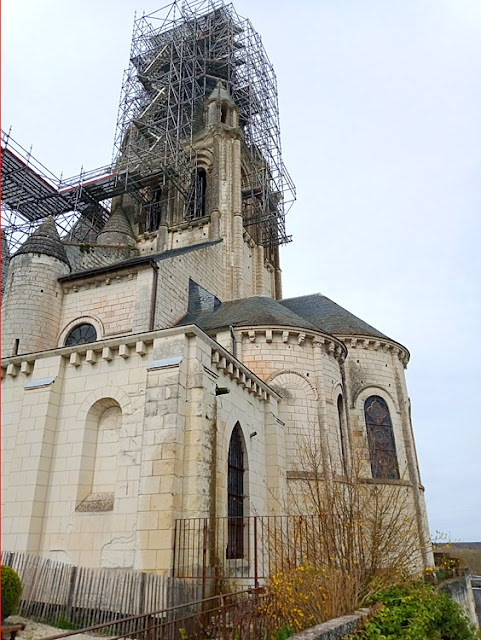In September last year the church of Saint Ours got struck by lightning and the east belltower was damaged. Since then it has been swathed in a maze of scaffolding and the town authorities, who own the building, are getting ready to repair it. The project will cost a quarter of a million euros, which is half the town's annual heritage buildings conservation budget.
Some years ago I had alerted the local swift conservation association SOS Martinets that there was a swift colony that nested in the roof and crevices in the walls of the church. So naturally they were very concerned when scaffolding went up, and arranged a meeting with the Technical Services Manager for the town. They invited me along and we presented the case for swift conservation.
Although he admitted he didn't know the difference between a swift and a swallow (fairly normal for the general public unfortunately) he was open to what we had to say. Fortunately the scaffolding isn't going to block the flight path or entry to any of the known nests. However, it was worth showing Frédéric Lardy well constructed nest boxes and alternatives for partially blocking niches to allow swift entry.
Frédéric Lardy, Technical Services Manager for the town Loches on the left, Carolyn and Tim Knowlman from SOS Martinet on the right.
We pointed out that if nest boxes go up they must be with the entry slot low down on the front, not at the top, as swifts have small weak legs and tend to plummet to the bottom of the nest box if forced to enter from the top. We also showed several methods of blocking up boulins (old wooden scaffolding holes) so that pigeons cannot use them as nest holes, but swifts can enter via a narrow slit and can nest in safety behind a piece of stone or slate. The result is aesthetically acceptable, in keeping with the building, and easy for the masons to install. We have had several sad instances where masons unknowingly have completely blocked and filled nest holes when buildings have been restored. Not only is this a disaster for breeding swifts, but they share the holes with lizards and insects, who are also put at risk when the holes are blocked.
Monsieur Lardy informed us that the municipal authorities are keen to add swift conservation to their list of responsibilities, and keen to let the public know they are doing so by putting something on the town website. Tim and Carolyn, my friends from SOS Martinets, are going to work on some text and provide photos. They also gave Monsieur Lardy some technical documents to help with ordering the construction and placement of a few temporary nestboxes on the scaffold. We don't expect the swifts to use the nests in this case but they serve to help raise awareness of their presence and importance.
Swifts flying around a nest site in Loches (photo from our archive).
The swifts are migratory and will arrive from Africa in May to breed in the Touraine Loire Valley, and they will leave again in August. They come back year after year to the same nest. There are several species, but in the Touraine we only get the so-called 'Common' Swift Apus apus (Fr. Martinet noir). Their population has plummeted in recent years by at least 50% but Switzerland, Italy and Spain have been doing great conservation work. I can tell you from personal experience that watching the swifts gregariously wheeling and making their distinctive screaming whistle aerial call whilst enjoying an aperitif on a summer evening in Florence or Granada will be one of the highlights of your visit to these cities. We hope Loches can be similar.
Further reading: SOS Martinets.




No comments:
Post a Comment